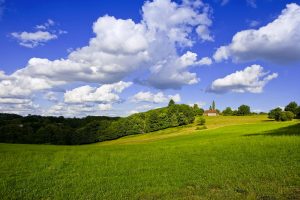 Mid April is the start of planting time for Hulled Bermuda grass. Bermuda seed germinates best when soil temperatures are above 70 degrees. After the soil is prepared, sow the seeds. The seeds should be covered with no more than .25 inches of soil. It will help if the cover soil is then lightly compacted (rolled). Keep the seed bed moist even if it requires watering several times a day. With ideal conditions Bermuda usually germinates within several weeks. But, there are many factors that can slow the germination; soil characteristics, temperature, and moisture being the top three. The above method applies whether you have bare dirt or you are over seeding an existing lawn. If you are over seeding a lawn you must first scalp the lawn and remove as much thatch as possible.
Mid April is the start of planting time for Hulled Bermuda grass. Bermuda seed germinates best when soil temperatures are above 70 degrees. After the soil is prepared, sow the seeds. The seeds should be covered with no more than .25 inches of soil. It will help if the cover soil is then lightly compacted (rolled). Keep the seed bed moist even if it requires watering several times a day. With ideal conditions Bermuda usually germinates within several weeks. But, there are many factors that can slow the germination; soil characteristics, temperature, and moisture being the top three. The above method applies whether you have bare dirt or you are over seeding an existing lawn. If you are over seeding a lawn you must first scalp the lawn and remove as much thatch as possible.
If this sounds like a lot of work, it isn’t. Preparing the soil means removing all unwanted plant growth and roughing up the surface. Sow the seeds with either a spreader or by hand (as evenly as you can). Cover the seed (.25 inch max) with compost or you can rake the seeds into the soil. Keeping the seedbed moist can be the hardest part of this task. If the seedbed dries out germination will be delayed.
The type of Bermuda we carry is called common. It is available in a 50# bag ($325.00) and we also sell it by the pound ($12.50). Application rates for Bermuda grass seed range from 1/2# for every 1,000 square feet to 1# every 250 square feet. My rule of thumb is 1# for every 500 to 750 square feet. (If you are not pressed for time, you can use one seed per acre!). When you buy Bermuda seed (or any other seed) look at the seed tag for the “Pure Seed” and “Germination” ratings. Our seed is listed as 98/85. That means it’s 98% pure seed and 85 seeds out of 100 will geminate. Bermuda seed is expensive, so know what you are buying.





